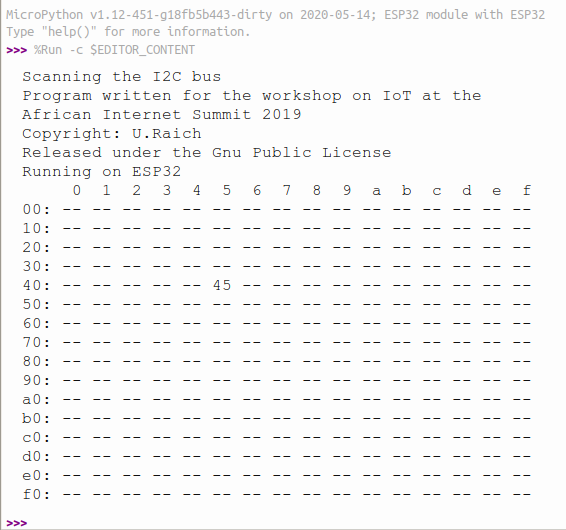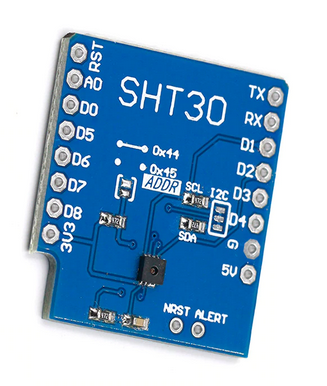Exercise 5: The I2C bus and the SHT30 Temperature and Humidity Sensor
Introduction
While the DHT11 uses a proprietary protocol the SHT30 make use of a standardized protocol: the I2C protocol, invented by Philips at the beginning of the 1980's. To get you going with I2C please have a look at https://learn.sparkfun.com/tutorials/i2c/allExercise 1: I2C Bus Scan
I2C is supported by a driver in the MicroPython In the example above only the SHT30 with its address B: 0x45 is connected to the I2C bus.
In the example above only the SHT30 with its address B: 0x45 is connected to the I2C bus.
Exercise 2: Read out the SHT30
First of all let's have a look at the SHT30 documentation The most interesting documents are
The most interesting documents areUsing a driver from github
This time we are going to be lazy (?) and just use a pure Python driver written by 'Roberto Sánchez which you can find on github at https://github.com/rsc1975/micropython-sht30/blob/master/sht30.pyExercise 3: Can you do better? (Bonus point)
Sensirion provides a driver written in C for the STM32-Discovery board (Sample Code Humidity Sensor SHT3x). Can you port this driver to the ESP32 and translate it into Python? Make a list of all functions the SHT30 provides and mark down, which of them are accessible by Sanchez’ driver. Can you write a driver that implements all functions the SHT30 provides? Solving this exercise requires quite some effort but you will learn how to read and analyze a data sheet and how to convert its information into working code. Finally you can integrate your code into MicroPython and make it available to others. The exercise sheet in odt format: https://afnog.iotworkshop.africa/pub/IoT_Course_English/TheI2CBusAndTheSHT30TemperatureAndHumiditySensorexercise_5.odt --Comments
| I | Attachment | History | Action | Size | Date | Who | Comment |
|---|---|---|---|---|---|---|---|
| |
SHT30Datasheet.pdf | r1 | manage | 919.8 K | 2020-05-14 - 15:18 | UliRaich | |
| |
Sensirion_Humidity_Sensors_SHT3x_Application_Note_Alert_Mode_DIS.pdf | r1 | manage | 334.6 K | 2020-05-21 - 21:08 | UliRaich | |
| |
exercise_5.odt | r1 | manage | 231.9 K | 2020-08-09 - 08:54 | UliRaich | |
| |
i2cscan.png | r1 | manage | 40.4 K | 2020-05-14 - 15:01 | UliRaich | |
| |
sht30-1.png | r1 | manage | 168.2 K | 2020-05-17 - 18:59 | UliRaich | |
| |
sht30.py.txt | r1 | manage | 6.5 K | 2020-05-14 - 15:29 | UliRaich |
Ideas, requests, problems regarding TWiki? Send feedback



